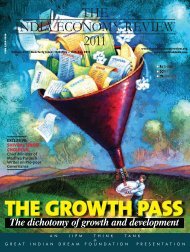Download - The India Economy Review
Download - The India Economy Review
Download - The India Economy Review
You also want an ePaper? Increase the reach of your titles
YUMPU automatically turns print PDFs into web optimized ePapers that Google loves.
P LANNING P ARADIGM<br />
nomic growth rate. According to a<br />
source, by 2008, <strong>India</strong> had established<br />
itself as the world's second-fastest<br />
growing major economy. However, the<br />
year 2009 saw a signifi cant slowdown in<br />
<strong>India</strong>'s Gross Domestic Product (GDP)<br />
growth rate to 6.8% which was largely<br />
because of world economic slowdown.<br />
Planning Commission where the ma-<br />
jority of experts are economists, since its<br />
inception has undergone sea changes. It<br />
has present-continuous aim and humble<br />
functions, broadly, to assessment of resources<br />
of the country; formulation of<br />
fi ve-year plans for effective use of these<br />
resources; determination of priorities,<br />
and allocation of resources for the Plans;<br />
determination of requisite machinery for<br />
successful implementation of the Plans;<br />
periodical appraisal of the progress of the<br />
Plan; to formulate plans for the most effective<br />
and balanced utilization of country's<br />
resources, to name a few.<br />
Proximate Cause to Nosedive and<br />
Characteristic Shifts<br />
<strong>The</strong> low productivity in <strong>India</strong> is a result<br />
of many instances, viz. agricultural subsidies,<br />
overregulation of agriculture, inadequate<br />
infrastructure and services and<br />
lastly but not the least, over-enthusiasm<br />
of politics sans polity.<br />
<strong>The</strong> above blackheads in functioning<br />
of the Planning Commission are because,<br />
in practice, it takes a forced backseat<br />
while welcoming always politics minus<br />
welfare-state policy. More so, the government’s<br />
thirst for intervention in all<br />
spheres of economic and social activity<br />
has far exceeded its ability to achieve<br />
positive outcomes in any of them. <strong>The</strong><br />
government sought to eat more than it<br />
could swallow. It is often felt that there<br />
has been a large gap between the theory<br />
70 THE IIPM THINK TANK<br />
of Government intervention and the<br />
practice of governance in <strong>India</strong>. <strong>The</strong> experts<br />
put it “theoretical accountability of<br />
politicians to voters is often thwarted in<br />
practice by sharing misappropriated<br />
public resources with special interest<br />
groups whose vote is critical to re-election”.<br />
All interventions are justifi ed by<br />
the ministers and bureaucrats as in the<br />
public interest or in the name of the Aam<br />
Aadmi or both. <strong>The</strong> long-term natural<br />
victim is Planning Commission.<br />
Lesson From the Past<br />
As the economists put it, a prima facie<br />
lesson of <strong>India</strong>n experience is that government<br />
monopoly is, in a low income<br />
democracy, more inimical to effi ciency<br />
and growth than a private monopoly because<br />
regulatory capture is much easier<br />
in the former. This is because either<br />
policy, regulation and ownership functions<br />
are vested in the same government<br />
department (monolith) or regulation and<br />
ownership functions are overseen/ controlled<br />
by the same department. In contrast,<br />
in the case of private monopoly,<br />
regulatory capture can be impeded by<br />
two layers of accountability; First an independent<br />
professional regulator and<br />
then the government department (to appoint<br />
& over see the regulator). So, deregulation/decontrol<br />
is often cried for in<br />
a right perspective.





